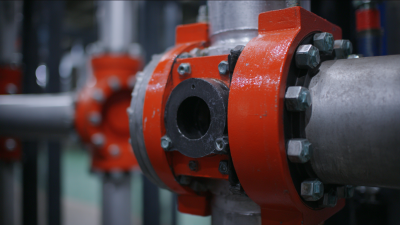In the construction and industrial sectors, the efficient management of piping systems is crucial for project success. Riser clamps, essential components for securing vertical risers in various applications, play a significant role in ensuring safety, reducing vibration, and facilitating maintenance. According to a report by the Global Construction Industry, the demand for riser clamps has surged by nearly 15% over the past five years, driven by advancements in building technology and increasing infrastructure projects worldwide.

When selecting the right riser clamp for a project, it is imperative to consider factors such as load capacity, material compatibility, and installation ease. Inadequate choices can result in costly delays and potential structural hazards. A detailed study from the International Association of Structural Engineers indicates that improper installation of riser clamps contributes to approximately 20% of common structural failures, underscoring the importance of making informed decisions. This guide aims to provide comprehensive insights into maximizing efficiency through the careful selection of riser clamps tailored to specific project demands.
Choosing the right riser clamp is crucial for ensuring the efficiency and safety of your construction project. Riser clamps come in a variety of types, each suited to specific applications. For instance, standard riser clamps are primarily used for vertical piping in mechanical systems, while cushioned riser clamps provide added protection for sensitive piping and reduce noise transmission. According to a report from the Plumbing-Heating-Cooling Contractors Association, improper riser clamp selection can lead to a 30% increase in maintenance costs over the lifespan of a building.
In addition to standard and cushioned clamps, there are also adjustable riser clamps, which allow for flexibility in installation as they can accommodate varying pipe sizes and materials. A study from the Copper Development Association indicates that the use of adjustable clamps can enhance labor efficiency by up to 20%, making them an ideal choice for projects involving numerous pipe adjustments. Understanding the distinctions among these types of clamps can significantly impact your project's overall performance and cost-effectiveness, ensuring that you select the most appropriate option for your specific needs.
When selecting riser clamps for your project, key features such as durability, safety, and versatility are crucial. According to a report by the American Society of Mechanical Engineers (ASME), approximately 30% of construction failures are linked to inadequate support systems, which underscores the importance of choosing high-quality riser clamps. Durable materials, such as stainless steel or high-grade plastics, are recommended as they ensure longevity and resistance to harsh environmental conditions. Clamps that meet the ASTM standards for material strength and load-bearing capacity can significantly reduce the risk of unexpected failures.
Safety is another paramount concern when selecting riser clamps. The Occupational Safety and Health Administration (OSHA) has reported that falls accounted for over 33% of construction site fatalities in recent years. Utilizing riser clamps that feature safety mechanisms, such as locking mechanisms and anti-slip designs, can enhance the overall safety of the installation. Additionally, versatility in design allows for the adaptability of clamps in various applications, which is vital in dynamic construction environments. A versatile clamp can accommodate different pipe sizes and configurations, allowing for a flexible and efficient installation process.
When selecting a riser clamp for your project, evaluating load capacity is paramount. Load capacity refers to the maximum weight the clamp can securely hold without risking structural failure. To ascertain the appropriate load capacity for your needs, consider the total weight of the pipes, cables, or conduits that will be supported. It’s essential to account for not just the static load but potential dynamic loads that may occur due to movement, temperature changes, or pressure fluctuations.
Furthermore, it is crucial to choose a riser clamp material that complements your project requirements. Materials commonly used include stainless steel, which offers strength and corrosion resistance, and plastic, which can be lightweight and cost-effective. Ensure that the clamp you choose is tailored to withstand the specific environmental conditions of your installation. Always consult manufacturer specifications and guidelines to guarantee that your selection meets the necessary safety standards and performance criteria, safeguarding both the integrity of your installation and the longevity of your project.
| Riser Clamp Type | Load Capacity (lbs) | Material | Recommended Application | Price Range ($) |
|---|---|---|---|---|
| Standard Riser Clamp | 500 | Steel | HVAC Systems | 20 - 35 |
| Heavy-Duty Riser Clamp | 1000 | Stainless Steel | Industrial Piping | 50 - 80 |
| Adjustable Riser Clamp | 750 | Aluminum | Electrical Conduit | 30 - 50 |
| Plastic Riser Clamp | 300 | PVC | Residential Plumbing | 10 - 15 |
| Vibrant Riser Clamp | 600 | Steel | Mechanical Systems | 25 - 40 |
When it comes to installing riser clamps, adhering to best practices is crucial for ensuring safety and efficiency in any project. According to a report from the National Fire Protection Association (NFPA), improper installation of riser clamps can lead to costly damage and safety hazards, with an estimated 30% of mechanical failures attributed to installation errors. To mitigate these risks, it’s important to follow specific guidelines that address load distribution and secure mounting techniques.
One fundamental practice is to always use clamps that are appropriately rated for the pipe size and weight involved. The American Society of Mechanical Engineers (ASME) advises that riser clamps should be able to support at least four times the anticipated load to account for dynamic forces, such as those caused by water hammer or seismic activity. Additionally, thorough inspection of the installation site and the clamps themselves before and after installation can significantly reduce the risk of future malfunctions, as noted in the Mechanical Contractors Association’s best practice guidelines.
By prioritizing these installation strategies, you can significantly enhance the longevity and reliability of your plumbing or electrical systems.
When selecting riser clamps for your project, the balance between cost and quality is crucial.
According to a recent report by the Construction Industry Institute, nearly 30% of construction inefficiencies stem from inadequate support systems, including misaligned or substandard clamps. Lower-cost options may seem appealing, but they often lack the durability and safety features necessary for long-term performance.
Investing in higher-quality riser clamps can mitigate risks associated with equipment failure and potential rework expenses, which can be up to 15% of a project's total budget.
In a comparative analysis by the Electrical Contractors Association, it was found that while premium riser clamps may have a 10-20% higher upfront cost, they deliver a significantly lower total cost of ownership over the lifespan of the project.
Features such as corrosion resistance and ease of installation can lead to decreased labor costs and reduced downtime. Ultimately, choosing the right riser clamp entails evaluating both initial costs and the enduring benefits they provide, ensuring that your investment truly aligns with project needs and expected outcomes.






